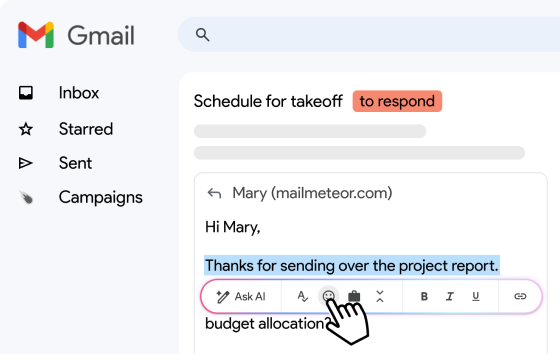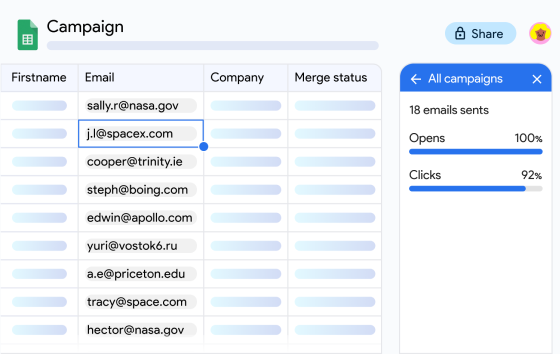Struggling with emails landing in spam or getting low open rates? Before your messages can be read, they have to reach the inbox – and that’s where email warm-up tools can help.
These tools gradually increase your sending volume, interact with your emails, and build a strong sender reputation, improving deliverability.
While not everyone needs one, they’re a game-changer for cold outreach, newsletters, and high-volume email campaigns where inbox placement matters.
But with so many options out there, which warm-up tool is actually worth using? And are there any other ways to boost your deliverability?
In this guide, we’ll compare the best email warm-up tools and help you find the perfect fit for your email strategy.
Here’s what we’ll cover:
- What Is an Email Warm Up Tool?
- How Do Email Warm-Up Tools Work?
- Why Use an Email Warm-Up Tool?
- 9 Best Email Warm Up Tools in 2025 (Reviewed & Compared)
- 1. Mailmeteor – Best for Gmail Users
- 2. Lemwarm – Best for Sales & Outreach Teams
- 3. Warmbox – Best AI-Driven Warm-Up Tool
- 4. Mailreach – Best for High-Volume Senders
- 5. Warmup Inbox – Best for Simple & Automated Warm-Up
- 6. InboxAlly – Best for Inbox Placement Optimization
- 7. Mailwarm – Best for Automated Warm-Ups
- 8. Instantly – Best for Multi-Account Warm-Ups
- 9. Mailivery – Best for AI-Powered Email Reputation Boosting
- How to Choose the Right Email Warm-Up Tool
- Tips to Improve Email Deliverability Beyond Warm-Up Tools
Sounds good? Then let’s dive in! 🚀
What Is an Email Warm Up Tool?
An email warm-up tool is a specialized software designed to gradually increase the sending reputation of a new or inactive email address.
Email providers like Gmail, Outlook, and Yahoo rely on sender reputation to determine whether an email should land in the inbox or the spam folder.
If an email account suddenly starts sending a large volume of emails, it may raise red flags, leading to poor deliverability or outright blocks.
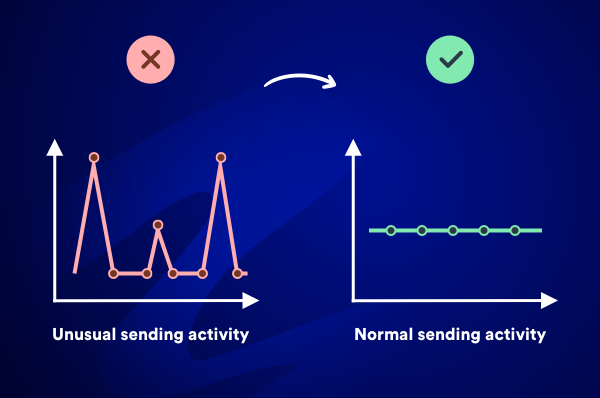
To prevent this, email warm-up tools simulate natural email activity by automatically sending and engaging with emails, like a human would.
This process helps establish your email as a trustworthy sender in the eyes of email service providers (ESPs), reducing the chances of being flagged as spam.
How Do Email Warm-Up Tools Work?
Email warm-up tools operate by mimicking real human interactions to create a positive sender reputation. Here’s how they typically work:
- Gradual email sending – Instead of blasting hundreds of emails right away, the tool sends a small number of emails per day, increasing volume over time. This prevents ESPs from detecting suspicious behavior.
- Engagement boosting – The warm-up network consists of real or simulated inboxes that open, reply, and mark emails as important. These interactions signal to ESPs that your emails are valuable, improving overall deliverability.
- Spam recovery – If emails land in spam, the warm-up tool removes them from the spam folder and marks them as not spam. This trains ESPs to recognize your emails as legitimate. Performance tracking – Advanced warm-up tools provide real-time insights into your sender reputation, inbox placement, and spam rates, helping you fine-tune your outreach strategy.
By automating this entire process, email warm-up tools ensure that your emails are well-received by ESPs before you start sending important campaigns.
Why Use an Email Warm-Up Tool?
If you’re sending emails from a new domain, a fresh email account, or an inactive inbox, using an email warm-up tool is essential to avoid low deliverability rates and spam folder placement. Here’s why warm-up tools matter:
- Improve inbox placement – Without a proper warm-up, emails from new accounts often land in spam. Warm-up tools help establish a positive sender reputation with ESPs.
- Reduce bounce rates – A sudden increase in email volume can lead to bounced emails, damaging your reputation. Warm-up tools gradually scale email activity to prevent this.
- Save time – Manual warm-up takes weeks of careful sending and monitoring. Warm-up tools automate the entire process, allowing you to focus on your email campaigns.
Email warm-up tools can be a game-changer for anyone who relies on email to grow their business. They can help avoid low open rates, missed leads, and a whole lot of frustration.
9 Best Email Warm Up Tools in 2025 (Reviewed & Compared)
With so many email warm-up tools on the market, choosing the right one can be overwhelming. We’ve reviewed the best options based on deliverability performance, ease of use, pricing, and additional features. Here are our top 9 picks.
1. Mailmeteor – Best for Gmail Users
Mailmeteor is a lightweight and easy-to-use email warm-up tool designed specifically for Gmail users. Unlike some tools that focus solely on warming up emails, Mailmeteor provides an all-in-one solution for email outreach, allowing users to warm up, personalize, and automate campaigns – all from their Gmail inbox.
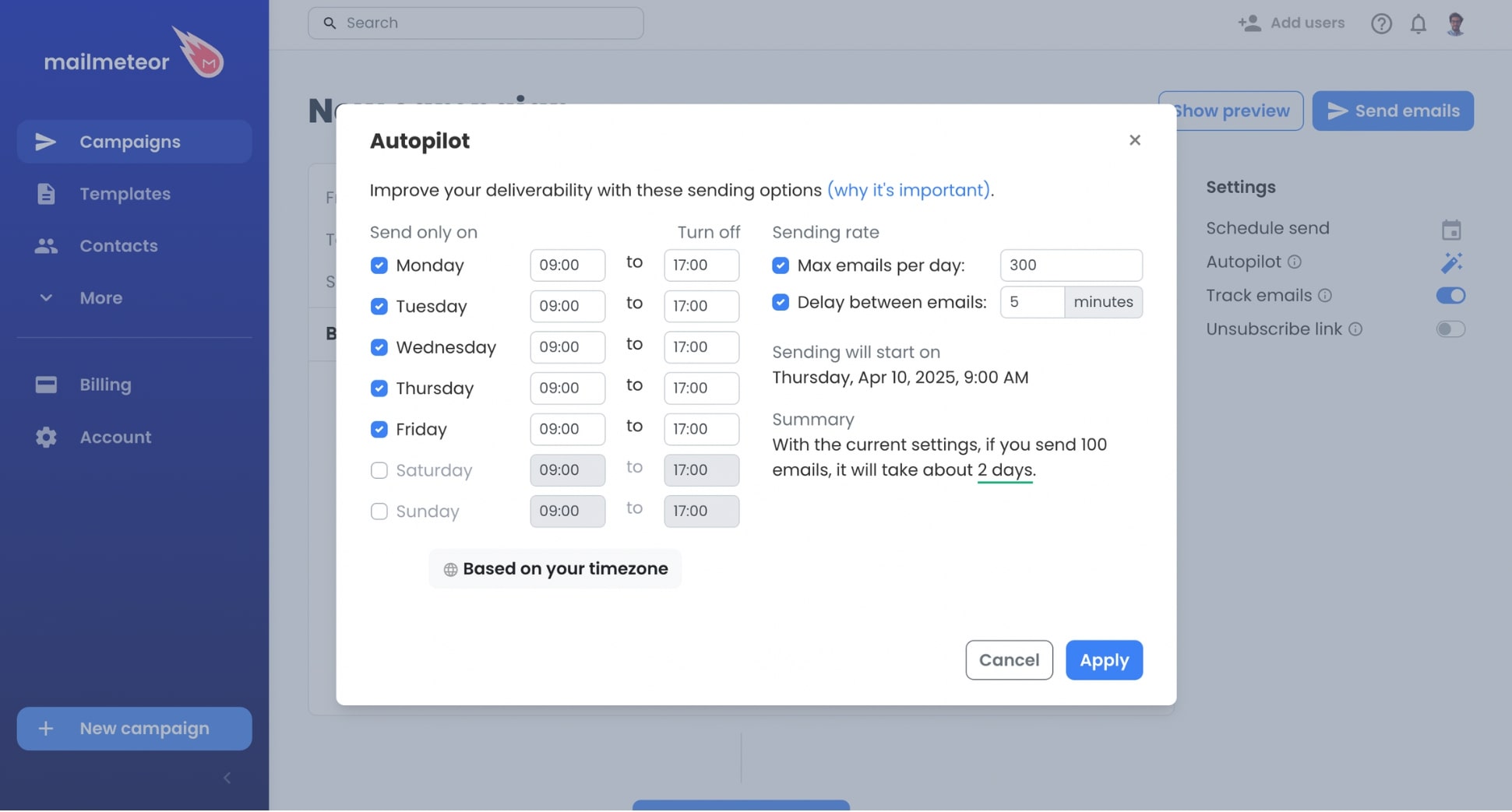
Key Features:
- Seamless integration with Gmail & Google Workspace
- Autopilot warm-up to improve sender reputation
- Email verification to reduce bounces
- Custom throttling & delay settings
- Affordable pricing & free plan
Best for: Gmail & Google Workspace users Pricing: Starts at $4.99/month Reviews: 4.9/5 on Google Workspace Marketplace
2. Lemwarm – Best for Sales & Outreach Teams
Lemwarm (by Lemlist) is a powerful warm-up solution designed for sales and outreach teams who rely on high-volume email sending. It mimics real conversations between real inboxes, helping improve sender reputation naturally.
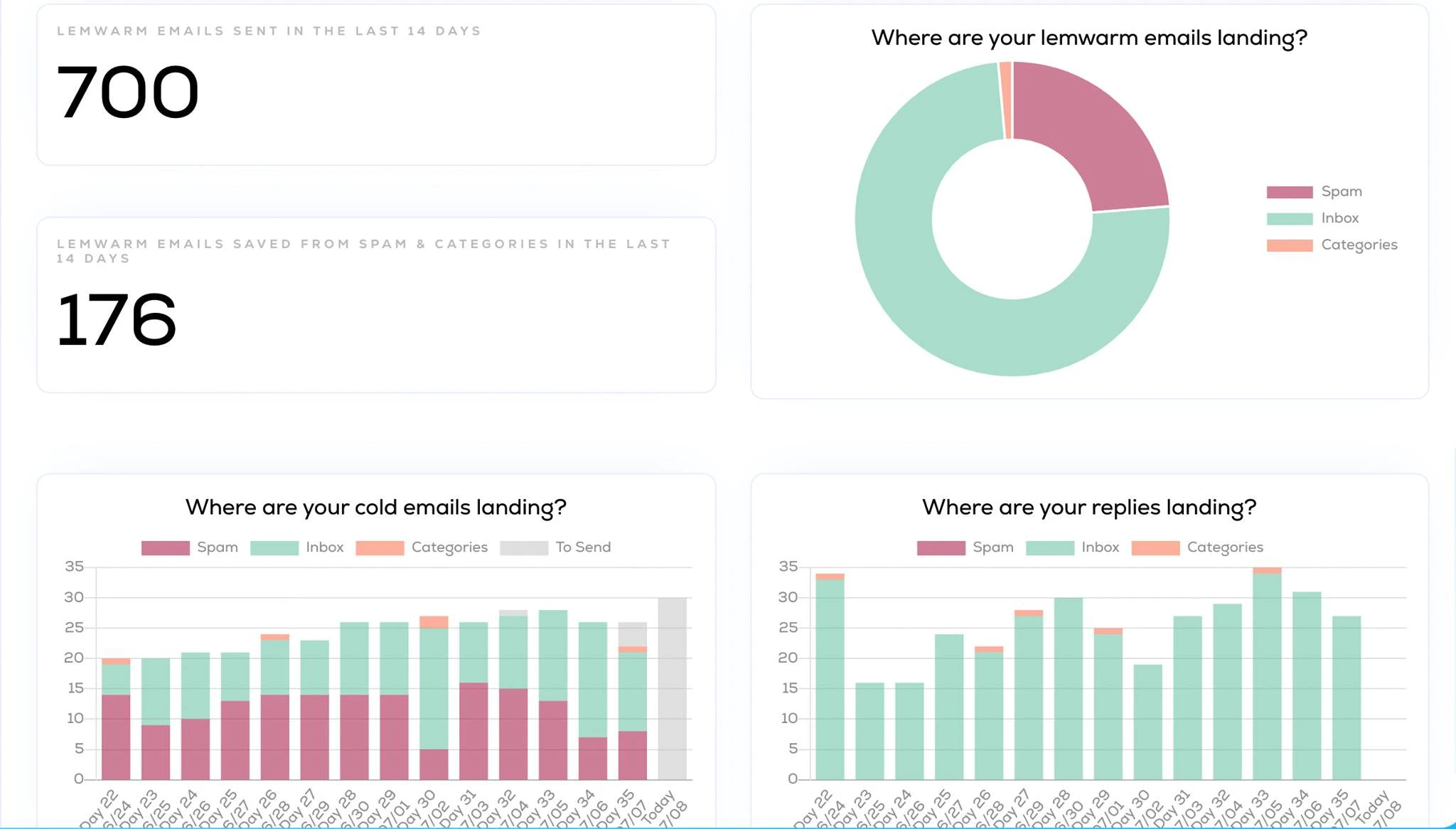
Key Features:
- AI-powered email warming
- Dedicated IP & domain warming
- Automated gradual volume increase
- Works with Google, Outlook, SMTP & more
Best for: Sales teams & cold outreach Pricing: Starts at $29/month Reviews: 4.5/5 on G2
3. Warmbox – Best AI-Driven Warm-Up Tool
Warmbox is a fully automated warm-up tool that uses AI to simulate real email engagement. Instead of just sending emails, Warmbox interacts with them, opening messages, replying, and marking them as important – boosting domain reputation faster.
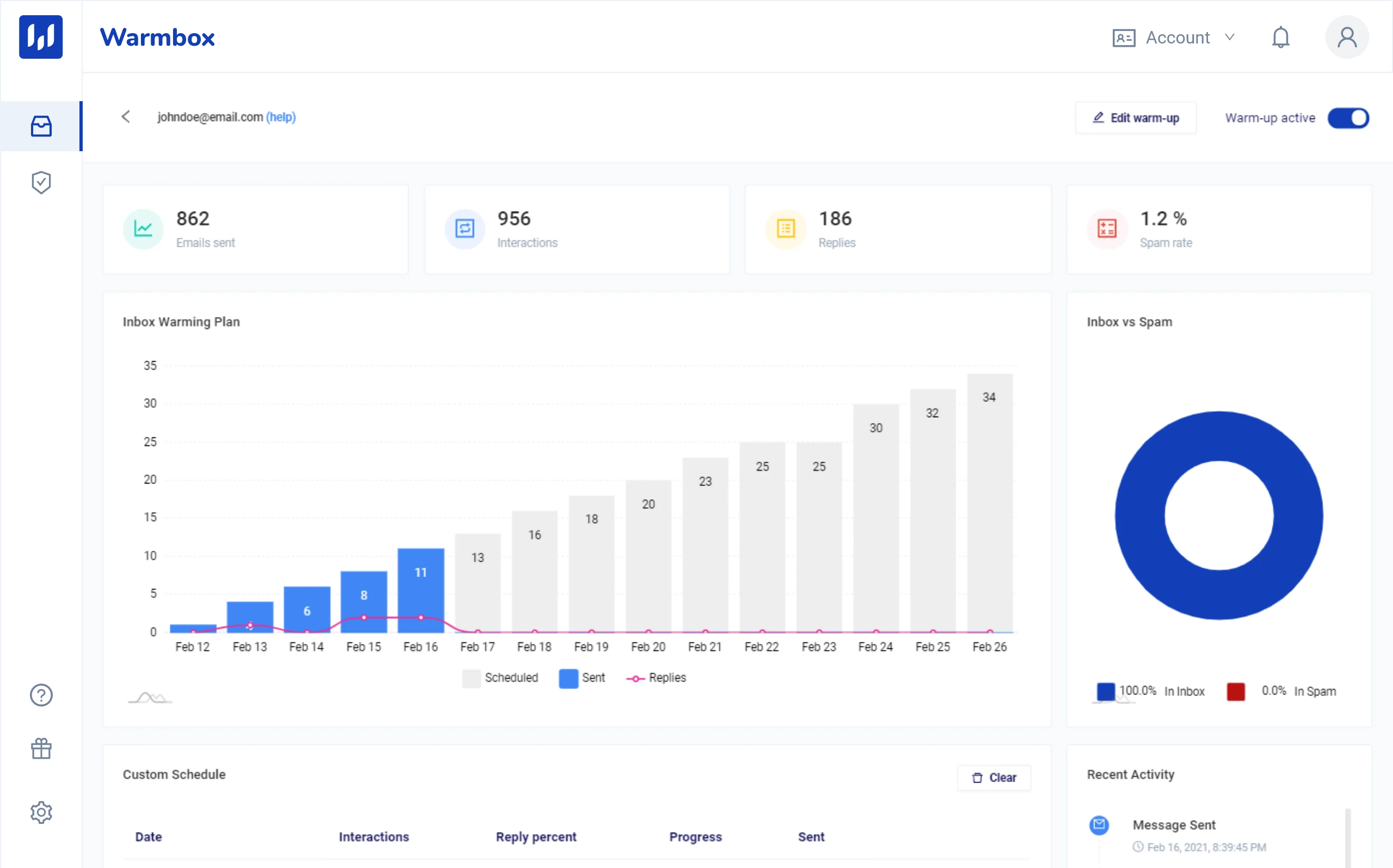
Key Features:
- AI-based inbox interaction
- Smart warm-up scheduling
- Works with any email provider
- Auto-generated conversations
Best for: AI-driven warm-up automation Pricing: Starts at $15/month Reviews: 4.7/5 on G2
4. Mailreach – Best for High-Volume Senders
Mailreach is one of the most advanced warm-up tools for high-volume email senders. It offers scalable warm-up automation, ideal for businesses and agencies sending thousands of emails per day.
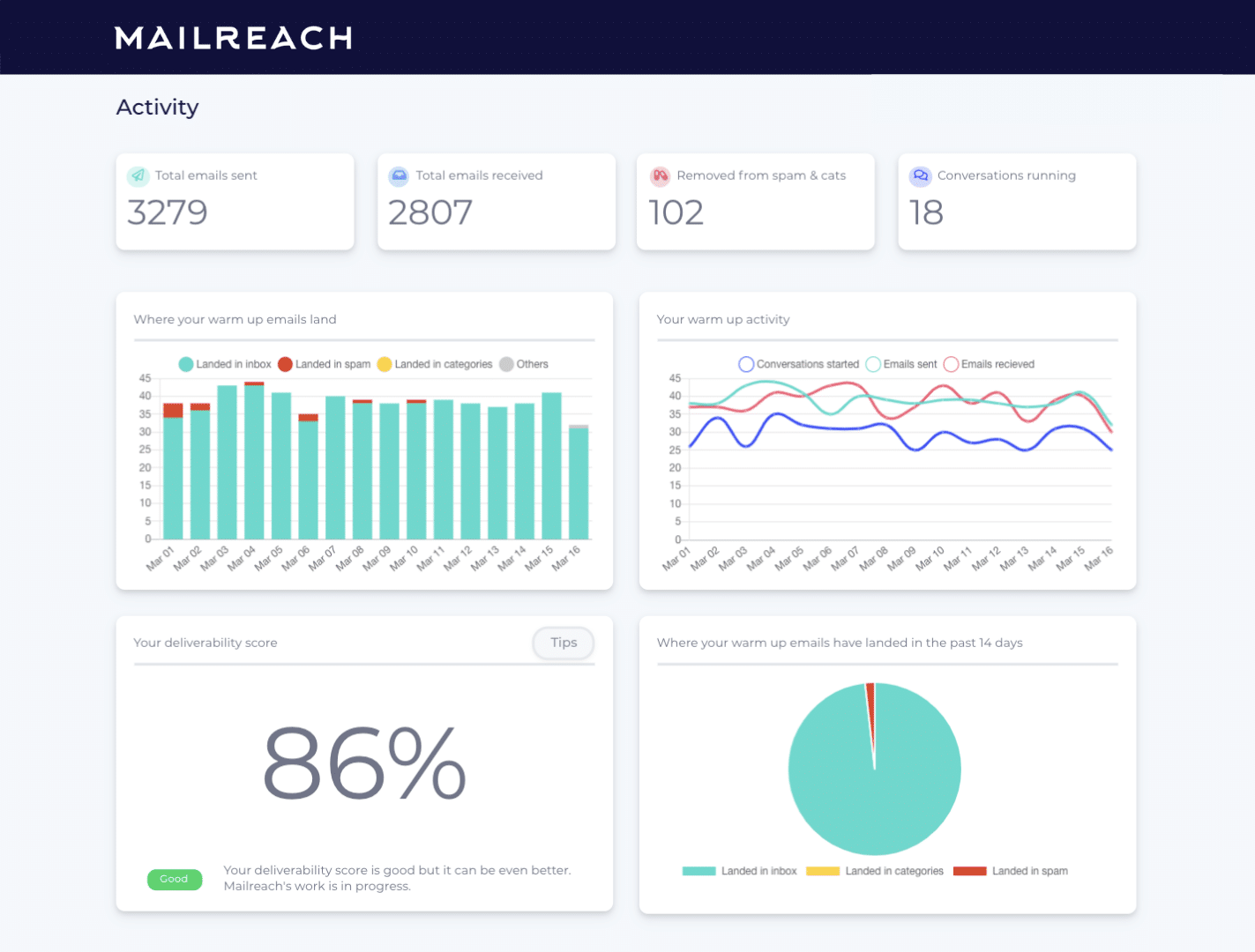
Key Features:
- Auto-warm-up with smart scaling
- Multi-email warming
- Inbox placement monitoring
- Works with all major ESPs
Best for: Large-scale senders & agencies Pricing: Starts at $25/month Reviews: 4.6/5 on G2
5. Warmup Inbox – Best for Simple & Automated Warm-Up
Warmup Inbox is a no-fuss, easy-to-use warm-up tool that automates inbox placement improvement. It slowly increases email volume over time, making it great for beginners or those warming up brand-new email domains.
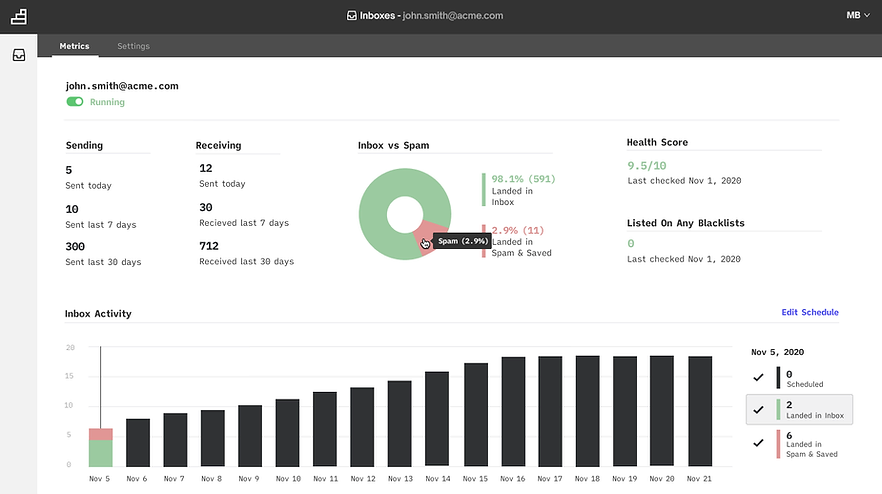
Key Features:
- Fully automated warm-up process
- Works with any ESP
- Inbox & spam placement monitoring
- Minimal setup required
Best for: Users who want a set-and-forget warm-up Pricing: Starts at $19/month Reviews: 4.7/5 on G2
6. InboxAlly – Best for Inbox Placement Optimization
InboxAlly focuses on placing your emails directly into inboxes, not spam. It does this by interacting with your emails naturally, boosting sender reputation faster than traditional warm-ups. But this tool is (very) expensive.
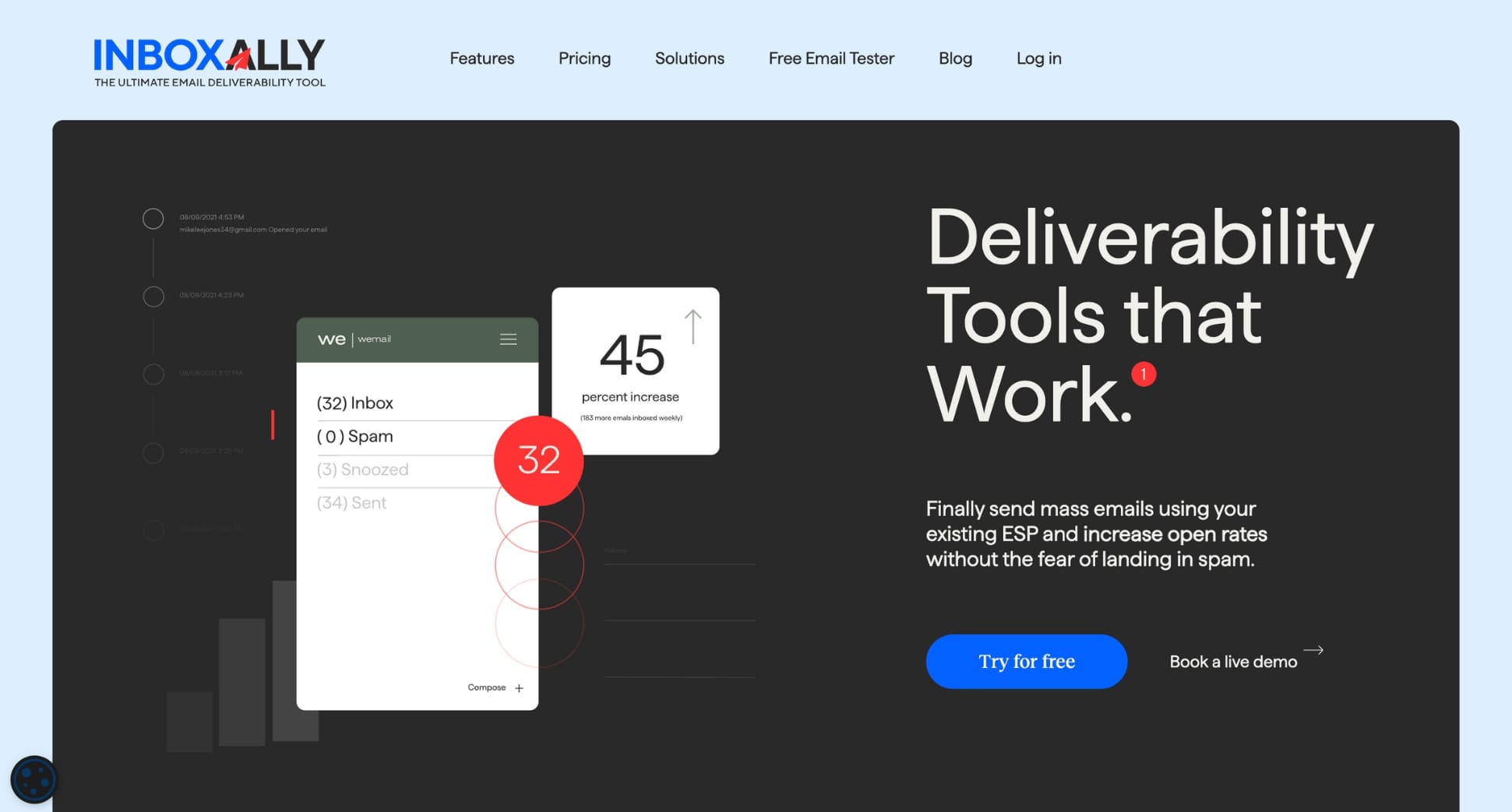
Key Features:
- AI-driven inbox placement optimization
- Best for transactional email senders
- Smart engagement simulation
Best for: Maximizing inbox placement Pricing: Starts at $149/month Reviews: 4.6/5 on G2
7. Mailwarm – Best for Automated Warm-Ups
Mailwarm offers a set-and-forget email warm-up process that gradually builds your sender reputation by engaging with real email accounts. You can track Mailwarm’s activity in real-time from your dashboard.
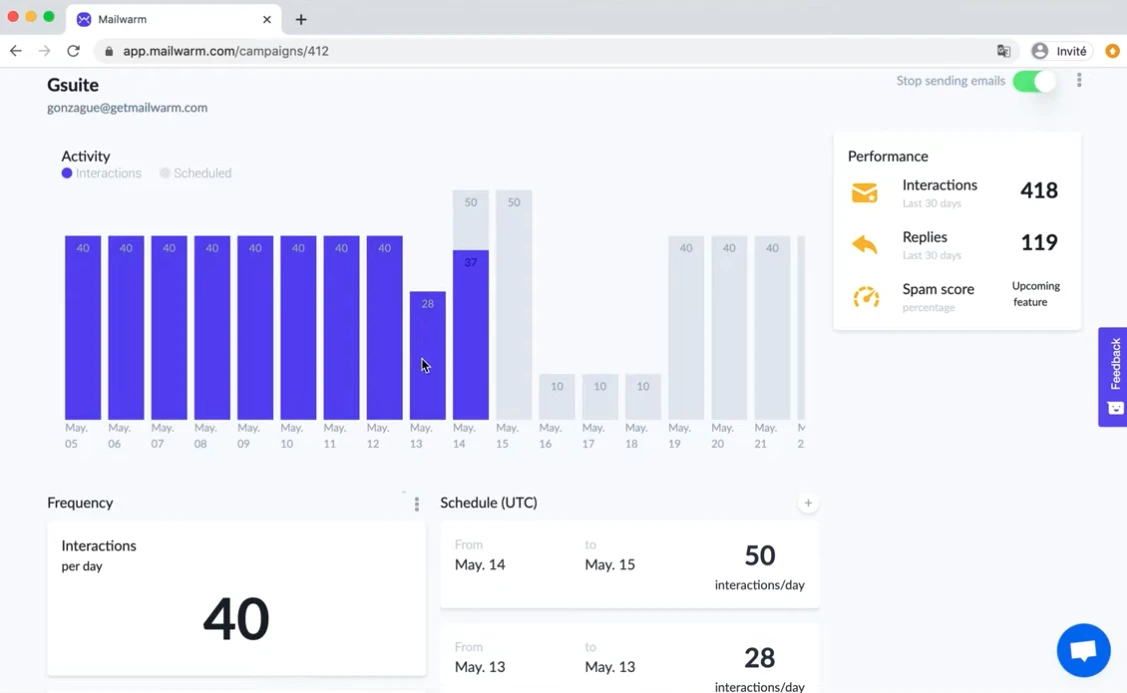
Key Features:
- Fully automated warm-up process
- Gradual increase in volume
- Works with any ESP
Best for: Simple, hands-free warm-ups Pricing: Starts at $79/month Reviews: 4.9/5 on Capterra
8. Instantly – Best for Multi-Account Warm-Ups
Instantly is an all-in-one cold email platform that includes email warm-up as part of its suite. It’s particularly useful for businesses or teams managing multiple email accounts, allowing them to warm up multiple inboxes at once.
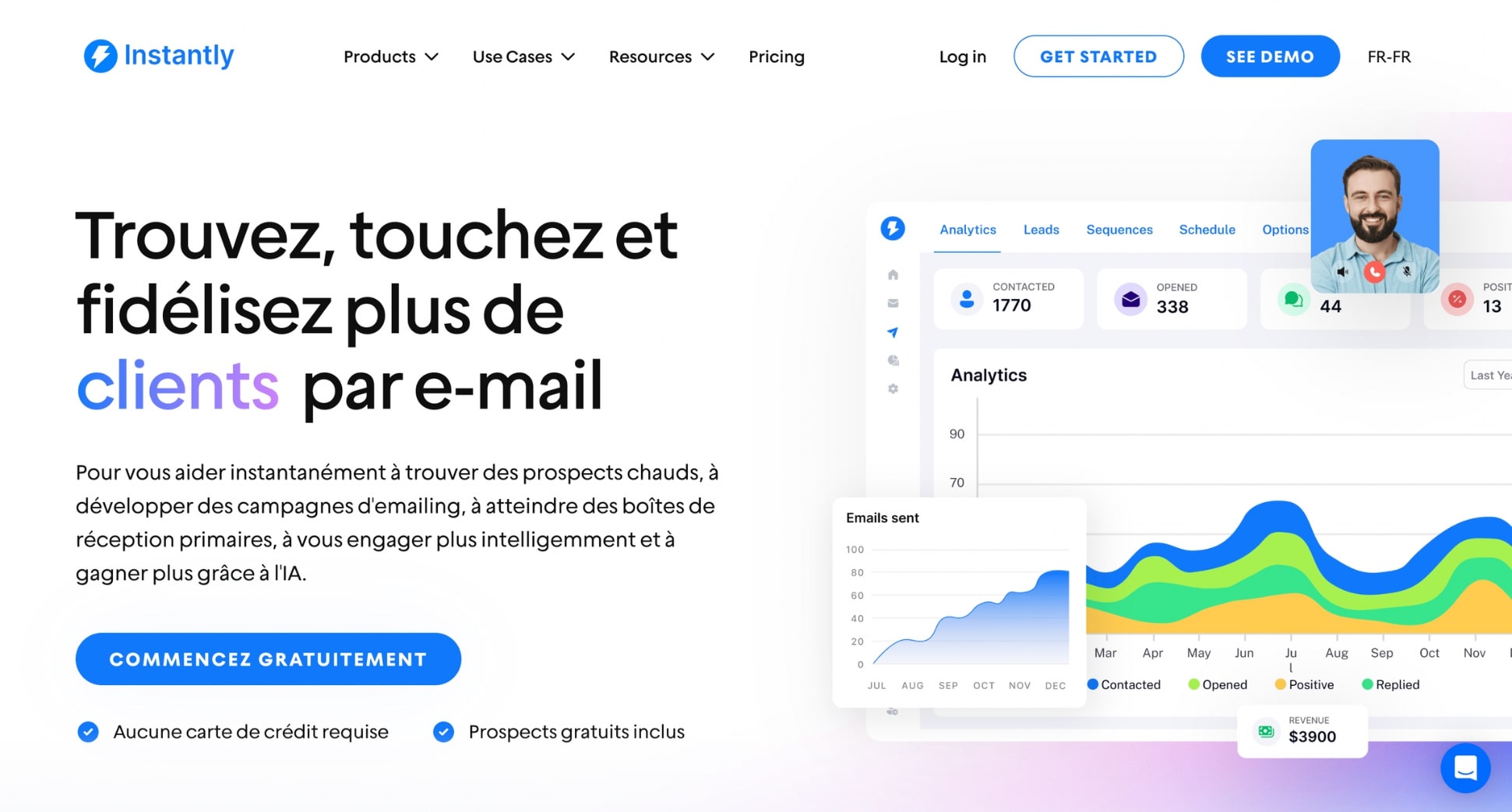
Key Features:
- Automated gradual scaling to build sender reputation
- Bulk email warm-up for multiple accounts
- Inbox placement tracking
- Cold email automation
Best for: Agencies & teams managing multiple inboxes Pricing: Starts at $37/month Reviews: 4.8/5 on G2
9. Mailivery – Best for AI-Powered Email Reputation Boosting
Mailivery uses AI to simulate real email interactions, improving email reputation faster than traditional warm-up tools. It’s ideal for users struggling with low deliverability or those needing to restore a damaged sender reputation.

Key Features:
- AI-generated warm-up sequences for organic engagement
- Works with Google, Outlook, SMTP & custom domains
- Inbox placement tracking & deliverability insights
Best for: Recovering flagged email accounts Pricing: Starts at $49/month Reviews: 4.8/5 on G2
Which email warm-up tool is the best?
The best email warm-up tool depends on your specific needs:
- For Gmail users: Mailmeteor offers a seamless Google integration.
- For cold email & outreach teams: Lemwarm or Woodpecker are great choices.
- For AI-powered inbox placement: Warmbox and Mailivery offer smart automation.
- For bulk warm-up & agencies: Mailreach and Instantly handle multiple accounts at scale.
How to Choose the Right Email Warm-Up Tool
With so many email warm-up tools available, choosing the right one can be tricky. The best tool for you depends on your email provider, sending volume, and specific needs. Here’s what to consider when making your decision:
Compatibility with Your Email Provider
Not all warm-up tools work with every email service. Some are built specifically for Gmail, Outlook, or custom domains. Make sure the tool you choose is compatible with your email setup. For example: Mailmeteor is ideal for Gmail users, while Mailreach supports multiple providers, including Outlook and custom SMTP servers.
Automation & AI Capabilities
A good warm-up tool should mimic real human interactions by sending and engaging with emails naturally. Advanced tools use AI to gradually increase your sending volume while avoiding spam triggers. For example: Warmbox uses AI-powered interactions to boost email reputation.
Inbox Placement & Deliverability Insights
Some warm-up tools, like InboxAlly, go beyond sending emails – they also provide inbox placement insights, spam detection, and deliverability reports. This helps you understand how your emails are performing and where they are landing, so that you can refine your outreach strategy.
Multi-Account Warm-Up Support
If you manage multiple email addresses, choose a tool that allows simultaneous warm-ups across different accounts. This is useful for teams, agencies, or businesses running multiple campaigns. For example : Lemwarm, Instantly and Mailreach let you warm up multiple email accounts at once.
Customer Support & Reputation
A warm-up tool is an investment in your email deliverability. Look for trusted providers with positive reviews, active customer support, and a good reputation in the industry. For example: Mailmeteor is rated 4.9 out of 11K+ reviews, and the app is used by 7M+ professionals worldwide.
Tips to Improve Email Deliverability Beyond Warm-Up Tools
Email warm-up tools can improve your sender reputation. But they’re just one piece of the puzzle. To maximize your deliverability, here are some key strategies that can help your emails consistently land in the inbox.
Set Up SPF, DKIM & DMARC for Domain Authentication
Email authentication protocols help prove that your emails are legitimate and not sent by spammers. Without these in place, your emails are more likely to be flagged as suspicious by email providers.
- SPF (Sender Policy Framework) – Specifies which mail servers are authorized to send emails on behalf of your domain.
- DKIM (DomainKeys Identified Mail) – Adds a digital signature to your emails, verifying that they haven’t been tampered with.
- DMARC (Domain-based Message Authentication) – Protects against phishing and spoofing by instructing email providers on how to handle unauthenticated messages.
Avoid Spam Trigger Words in Subject Lines & Emails
Spam filters scan email content for words and phrases commonly associated with scams or overly aggressive marketing. Using too many spam trigger words can hurt your inbox placement.
- Don’t use misleading phrases like Urgent! or Final Notice.
- Avoid excessive CAPS and exclamation marks (!!!).
- Don’t add multiple emojis in subject lines.
Maintain a Healthy Sending Schedule
Sending too many emails too quickly – or irregularly – can damage your sender reputation. Email providers look for consistent sending patterns. If they detect sudden spikes in activity, your emails may be throttled or blocked.
- Start with a low daily sending volume and gradually increase.
- Avoid sending bulk emails from a brand-new email account.
- Space out emails to avoid sending too many at once.
Personalize Your Emails for Higher Engagement
The more personalized your emails, the higher the engagement rates – and the better your sender reputation. Low engagement signals to email service providers that your messages aren’t valuable, increasing the risk of spam filtering.
- Use the recipient’s first name in the subject line or greeting.
- Reference specific details about their company, industry, or interests.
- Segment your audience and send highly relevant content.
Clean Your Email List to Avoid High Bounce Rates
A high bounce rate (emails that fail to deliver) can damage your sender reputation. Removing invalid or inactive email addresses helps keep your list clean and ensures better deliverability.
- Use email verification tools like ZeroBounce, NeverBounce, or Mailmeteor’s built-in verifier.
- Regularly remove unengaged subscribers (people who haven’t opened your emails in months).
- Monitor your bounce rate – anything above 2% is a red flag.
Final Thoughts
Email warm-up tools are a powerful way to improve your sender reputation and increase inbox placement, but they’re not a magic fix. Even with the best warm-up process, poor email practices can still land your emails in spam.
For truly effective email outreach, you need a well-rounded approach. Tools like Mailmeteor go beyond warm-ups by offering key features to elevate your email deliverability to new heights, including:
- Email verification to prevent bounces
- Email throttling to mimic human-like sending patterns
- Personalization features to boost engagement
So, while warming up your email is important, don’t stop there. Combine it with strong deliverability best practices, and you’ll see better open rates, higher response rates, and ultimately, more success in your email campaigns.
FAQs
What’s the best email warm-up tool for Gmail?
The best email warm-up tool for Gmail users is Mailmeteor. It integrates directly with Gmail and Google Workspace, making it a seamless, automated solution for improving email deliverability without requiring additional software.
How long should I warm up my email before sending campaigns?
It depends on the age of your email account and your sending volume:
- New email accounts: Warm up for at least 3–4 weeks before sending mass emails.
- Inactive accounts: Warm up for 2–3 weeks to rebuild a positive sender reputation.
- Existing accounts with some activity: Warm up for at least 1–2 weeks before scaling up email volume.
Some email warm-up tools like Mailreach and Warmbox offer AI-driven warm-up schedules that adjust based on your domain reputation.
Can I warm up multiple email addresses at the same time?
Yes, many email warm-up tools allow you to warm up multiple email addresses simultaneously, including Lemwarm, Instantly and Mailreach. This feature is especially useful for teams, agencies, and businesses managing multiple domains or outreach campaigns.
Do I need to warm up an email that has been inactive for a while?
If an email account hasn’t been used in months, its sender reputation declines, making it more likely to land in spam. To reactivate an old email:
- Start a warm-up process for 2–3 weeks before sending large campaigns.
- Gradually increase your email volume (avoid sudden spikes).
- Engage with real users (open, reply, and forward emails to simulate human behavior).
Warm-up tools like Mailreach and Inboxally help recover the reputation of inactive email addresses.
What’s the best free email warm-up tool in 2025?
Finding a truly free email warm-up tool is challenging, as most providers now include warm-up as part of their paid plans. However, some tools offer free trials or limited warm-up features:
- Mailmeteor – Lets you send up to 50 emails a day (but automated email warm up is a paid feature).
- Warmup Inbox – Offers a 7-day free trial.
- Mailivery – Provides a limited free trial, allowing users to test automated inbox placement improvement.
- Lemwarm – Comes with a 14-day free trial.


